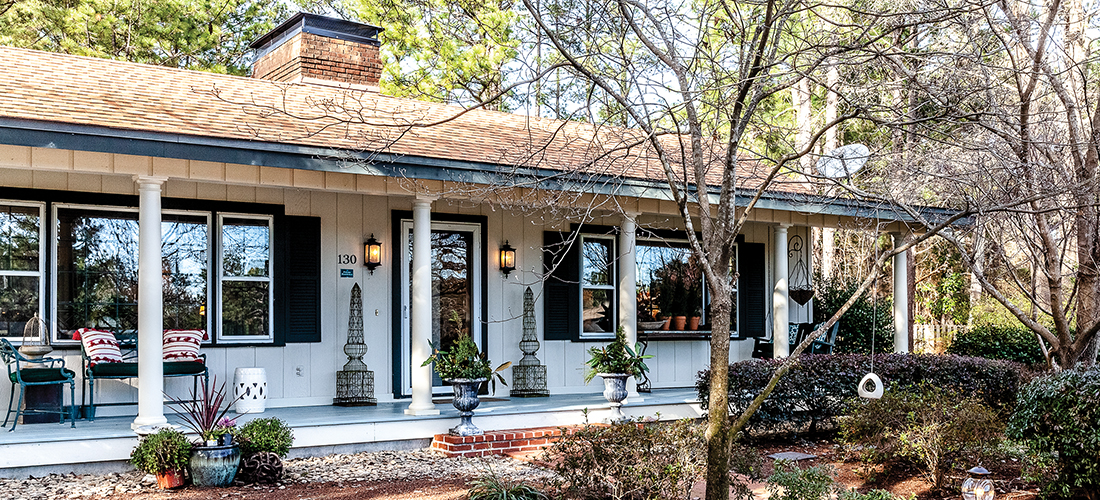
Mother-daughter business keeps them close to home
By Deborah Salomon • Photographs by John Koob Gessner
Know a person by his or her house.
In the case of Denise O’Reilly, horse art, dog art, windows overlooking a paddock, the color turquoise, magazine-perfect decor located a few yards from her daughter and grandchildren tell the story.
Denise — equestrienne, interior designer, part-time May Street resident who summers in Florida — helps daughter Lindsay O’Reilly operate Tanglewood Farm Bed and Breakfast, where guests, riders or not, soak up the atmosphere provided by dogs, horses, chickens, rabbits and a big yellow barn cat.
Here, political wrangling and faraway conflicts are drowned out by whinnies and clucks.
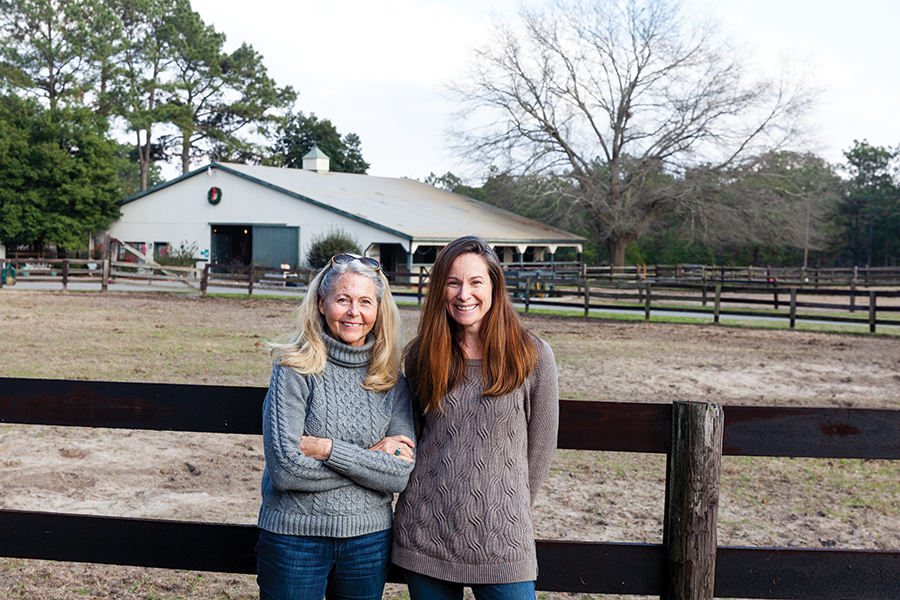
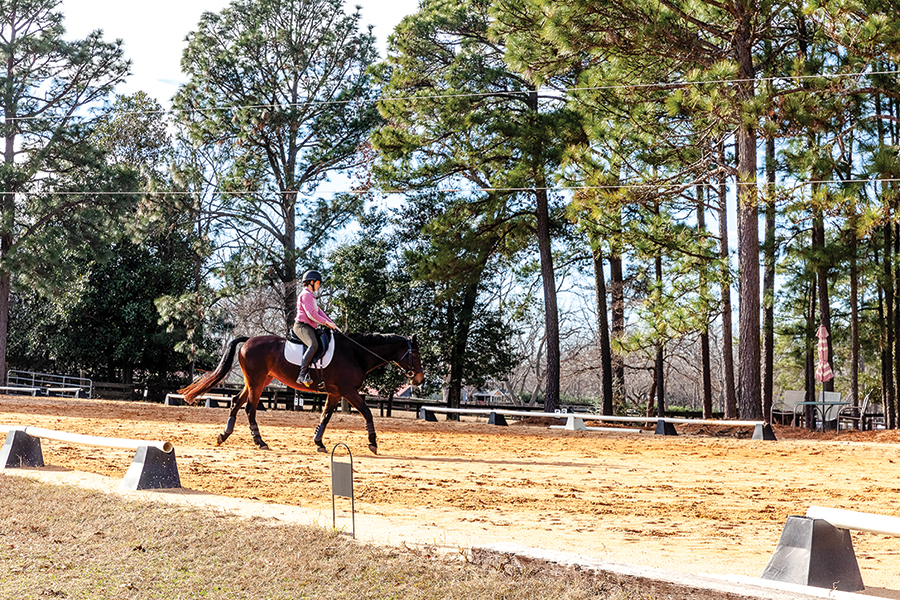
Horse farms usually include hunt boxes, the English way of lodging weekend foxhunters and their mounts under the same roof, with stalls either beside or beneath an apartment. Some were rustic, others grand, still others, like Tanglewood, became freestanding cottages near the barn. Tanglewood deceives the eye. What appears to be an unremarkable cottage of modest size stretches back nearly 3,000 square feet with an interior marrying sophisticated to what Denise calls “comfy.”
A lifelong horsewoman, Denise lived in frigid Wisconsin for 37 years, where she owned a training stable and built a dream house. Lindsay started lessons at 7 and competed in eventing, as had her mom. When Denise’s circumstances changed she moved to Florida but knew of the Southern Pines community — and eventually contacted a Realtor. Coincidentally (or not) Lindsay, a CPA, chafed to relocate from an urban high-rise lifestyle. “I wasn’t happy. I wanted my own business,” Lindsay explains. “I love to cook and entertain. We had talked about a B&B in Florida.”
Of course, operating a B&B is more changing sheets and scrubbing tubs than pouring coffee and serving eggs Benedict. First, Lindsay’s husband, Randy Sharpe, a personal trainer, had to be convinced.
Considering these circumstances, finding Tanglewood with its farmhouse and outbuildings was near miraculous, especially because the cottage demanded upgrading and Denise possessed the skills. “When I first walked through I could place every piece of my furniture,” says Denise. She purchased the property — which had seemed too big before Lindsay’s B&B proposal — in 2012.
Tanglewood’s history is scarce, except for the time a lady stopped by to tell Denise she had grown up there in the 1960s, also that the B&B cottages were her father’s workshop and all their horses were buried along the fence line. After that, Robert Costello, who competed in the 2000 Olympic Games, lived in the farmhouse for 20 years, beginning in the 1990s. “We bought it from the bank, for next to nothing, because of the barn and the manageable size (11 acres),” says Costello, who still lives nearby. “The Olympic team would come here for training sessions, stay for weeks. It was a great party house.”
Such was the post-party state Denise faced: dark wood paneling, dated carpet and tile floors, “very masculine,” her take.
But nothing could take away from looking out oversized windows at her grazing horses.
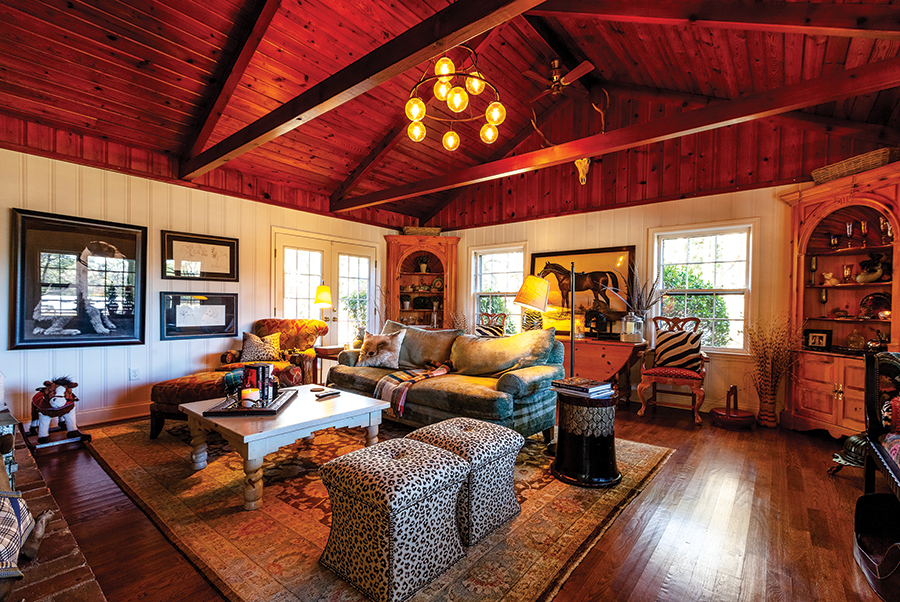
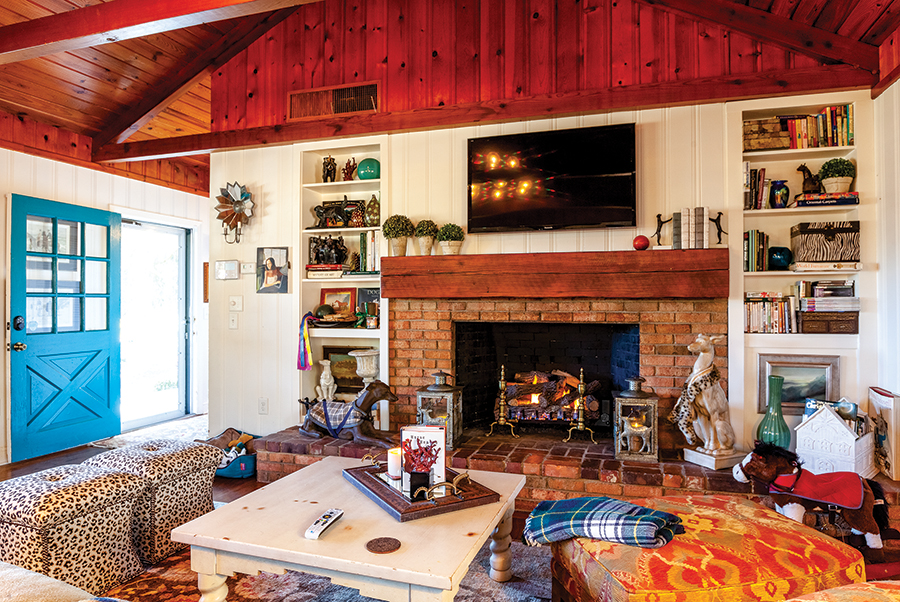
As with most farm-style houses, this one centers around the kitchen, the only room Denise gutted. She especially liked the raised brick fireplace with a slab mantel cut from a local tree and the vaulted wood-paneled ceiling, which she left intact. Other paneling is now painted shady white. Between the fireplace and the equally massive island with a top made from reclaimed wood joined by pegs is a small sitting area with two overstuffed chairs, upholstered in unlikely smoky-turquoise velvet reflecting the opposite kitchen wall of turquoise ceramic tiles. Red countertop appliances provide pop.
Following the trendy farmhouse modern mode, Denise replaced some hanging cabinets with single shelves that hold a few artfully placed dishes. Over the sink, a picture window with sightline to the upper barn where she and Lindsay keep two horses.
“The barn is my happy place,” Denise says. “I love taking care of the horses. (Lindsay and I) used to fight over who cleaned the stalls.”
The long family dining table stands at the front window facing the paddock. Its legs resemble a pencil, shaved to a point. Rather than family heirlooms, Denise’s furnishings, all chosen with a designer’s eye, arrived via High Point. They own no particular style but co-exist amicably with each other and ceramic dog-base lamps, paintings of her schnauzer Brody and other animals. Nowhere is Denise’s ability to juxtapose better displayed than the living room, also with a fireplace, where a vaulted pine ceiling (think ski or hunting lodge) synchronizes with a turquoise velvet sofa, leopard-print ottoman-tables, colonial corner cupboards, built-in bookshelves.
Denise doesn’t miss a detail. The living room window looks out onto plants arranged on a window-height table on the wide front porch. This effect brings outside in, inside out.
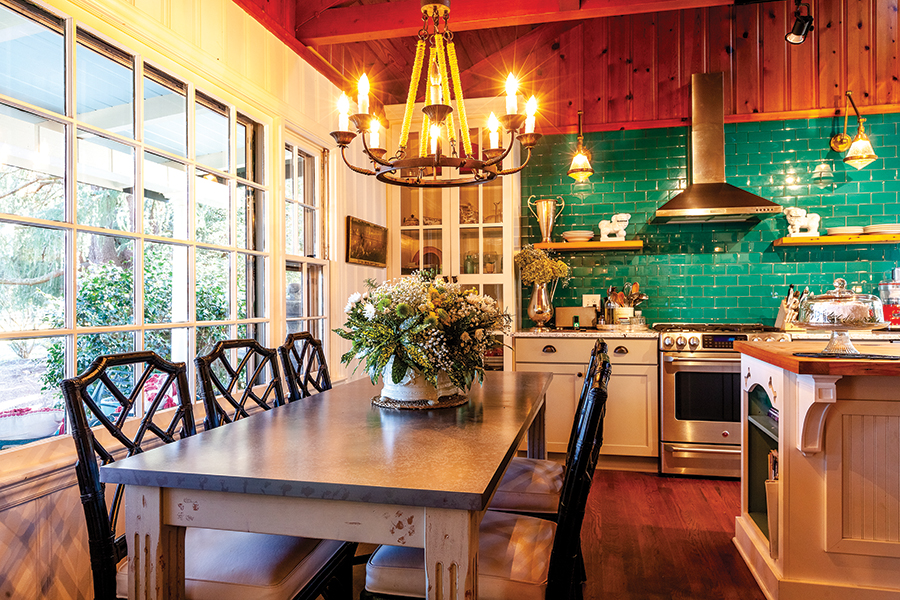
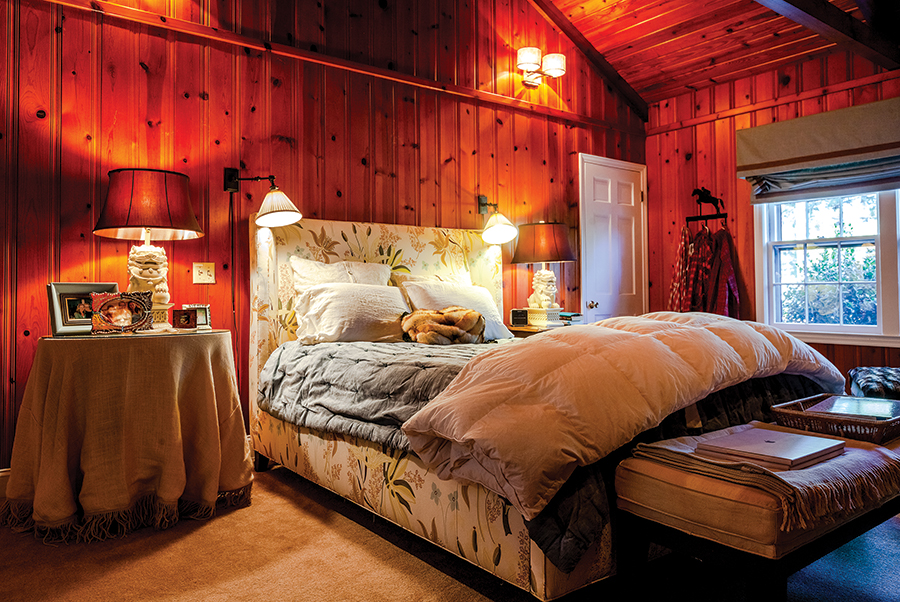
Extending back from the kitchen, a hall and huge porch have been joined, enclosed and repurposed as a dining room and, without any divider, an office.
“I needed a dining room and I needed an office,” Denise explains, while admitting that the office end, with turquoise desk, is used primarily for paying bills. Two guest bedrooms line the hall, with her master suite at the end. Here, surprisingly, she has not painted the wood paneling. “It’s cozier this way.” Again, turquoise and complementary colors, just enough family photos and animal art.
Rugs are Denise’s passion. “I don’t have enough floor space to put them all down. Some are rolled up under beds.” This addiction comes from studying the art of rug-making, how design elements and colors mean different things. She also learned that exquisite hand-woven carpets don’t need to be babied, which is why so many live to be antiques. “They are indestructible.”
They are also everywhere, providing a palette of colors played out in upholstery and drapery fabrics.
The sticks and stones may be pretty but central to Tanglewood Farm is the mother-daughter relationship. Lindsay hasn’t lived at home since she was 17. After relocating to Southern Pines she first lived downtown, which meant lots of back and forth while managing the units. She and her husband recently built a home a few steps away from Denise’s renovated farmhouse. Boundaries aren’t a problem; they share some B&B duties (including both the dirty work and preparing unusual breakfasts), visit back and forth frequently, eat together occasionally. Lindsay’s 4-year-old son, Flynn, is a regular at Granny’s, but since he and a younger sister have a full-time nanny, babysitting isn’t part of the equation.
“At least if something happens there’s somebody to call,” says ever-practical Denise.
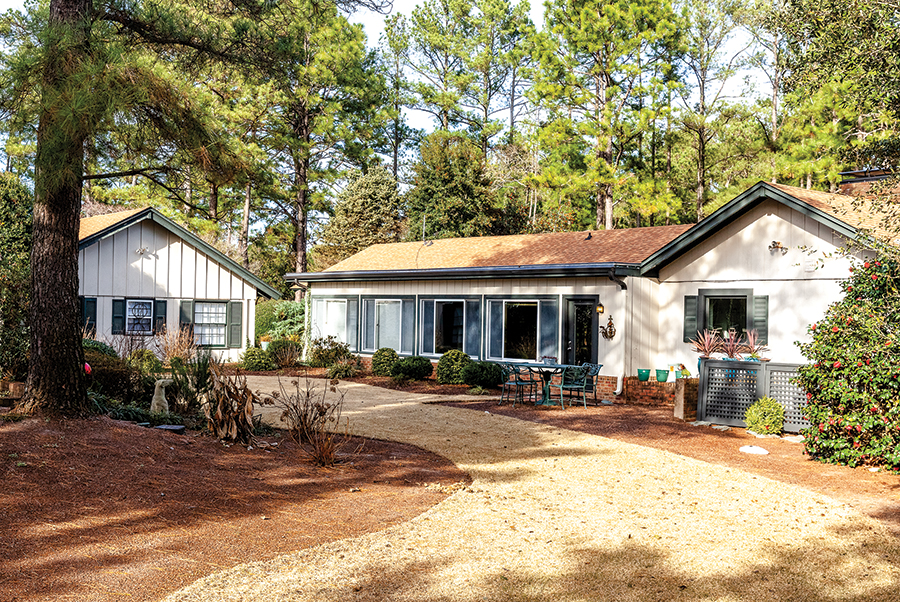
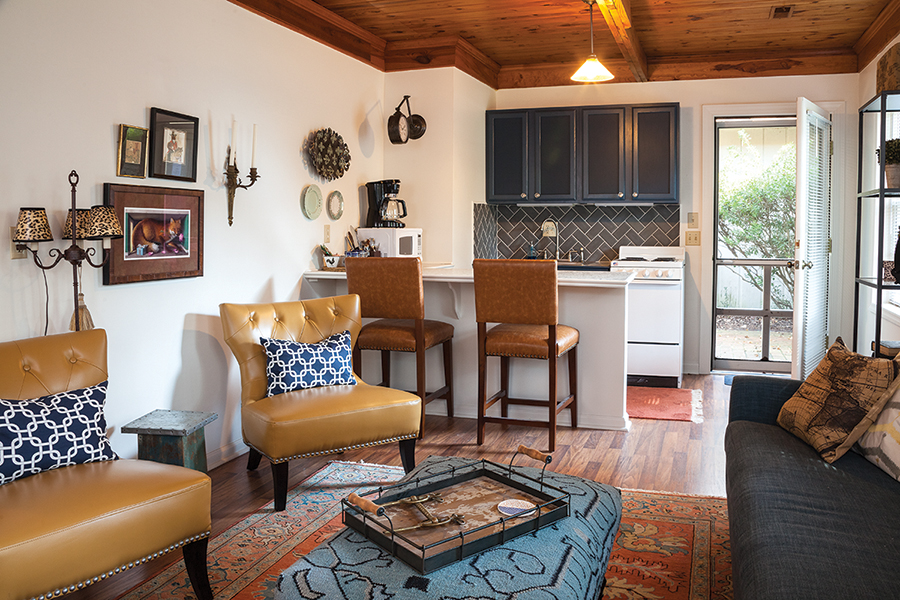
Since several of the B&B units border the owners’ patio and garden, guests intermingle, become friends and return.
None of this was planned, by mother or daughter, yet Denise recalls thinking how nice it would be to have a family compound, where all three of her children could gather.
And it happened.
“I’m so lucky to have Lindsay here and to be able to watch my horses outside the window,” says Denise, wearing stylish high riding boots. “It worked out so well that sometimes I just have to pinch myself.” PS





